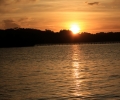Dr. DoLittle Center
“Let me do it, otherwise we’ll never have it,” I said with exasperating tone. Meidy insisted on finding a carpenter albeit we had offered the job to a number of them and all turned it down. One of them said that $400 was too little for building the DoLittle Center. The offer is actually above local standard but they expect that we—a non-local couple who have lived here for four years—pay them as much as the owners of the resorts around us did. They just don’t care that the building will be used for their children and the local tourist guides learning English and other knowledge and skills with no charge. We could pay them more but then the grant from the Primate Conservation Inc. would not be enough for buying a mini laptop—my 7-year old one has been in trouble all the time—slide projector, speaker, and wages for the person helping me with trail clearing in the forest.
“Are you sure you can do it?” she asked that question, again. It is in fact a reasonable question because I was trained for healing human not for building a house, but she has seen that I have done various things outside my medical skills.
“Yes,” I lied, “I am sure. I am going to hire a local to help me out.” Constructing a 6m x7m building is not a trivial work and I am not fit enough to do sawing wood–many of them hard ones—hammering hundreds of nails, digging deep holes, and lifting heavy logs for roof structure. She, however, stopped expressing her doubt afterwards.
When we came to Malenge in 2014, we had planned to construct a hut for our carpenter and his wife, a temporary shelter for us, our house, and a building for conservation education and ecotourism training in that sequence. We did the first three but not the last one. On finishing the house, our money was only enough to support our life, even at subsistence level, for less than a year. Since then we have lived frugally by eating whatever edible around our home—later from our garden—buying fish only from the fishermen who come once a week on the average, and having beef every six week when Meidy returns from the harbor town of Ampana (6-hour public boat).
We make some money from tourists who stay in our guest hut—we converted our temporary shelter by installing a toilet to it—but not every month we have them; another source is the donation from the tourists I walk in the jungle but only in summer holiday more than four persons do trekking per month
Though I practise ‘do not mourn for the past, do not worry about the future, live . . .’ I failed to do so when the money in my bank account only enough for three months of living. A miracle happened: Nat Cohen—without being asked for—sent me $6000. It has covered our life more than a year.
Meanwhile I sent some grant proposals to 5 conservation funding agencies but only the Primate Conservation Inc. granted my proposal. I am grateful to Dr. Jane Goodall, Eric Chivian MD, and Noan Fesnoux for their time on reviewing my proposal, and I appreciate much the kindness of Dr. Noel Rowe, the Director of the PCI, for taking care of my proposal.
Having work hard for one month—I had wrist-ache and backache every night—now Meidy and I are very proud looking at the DoLittle Center from either our house windows or our boat on the ocean in front of our bay. Under the shade of DoLittle the children enjoy reading, learning and playing and the tourists who have just come back from the forest enjoy young coconuts and Meidy’s pancake. Some of them—looking at the clear blue calm ocean and the lust green cliffs—say, “do you know that you live in paradise.” Of course I know, but they don’t know that paradise is not an easy life for us. It is, however, our decision to have this way of life. And we don’t regret because we have a peaceful and meaningful life on Malenge Island.





